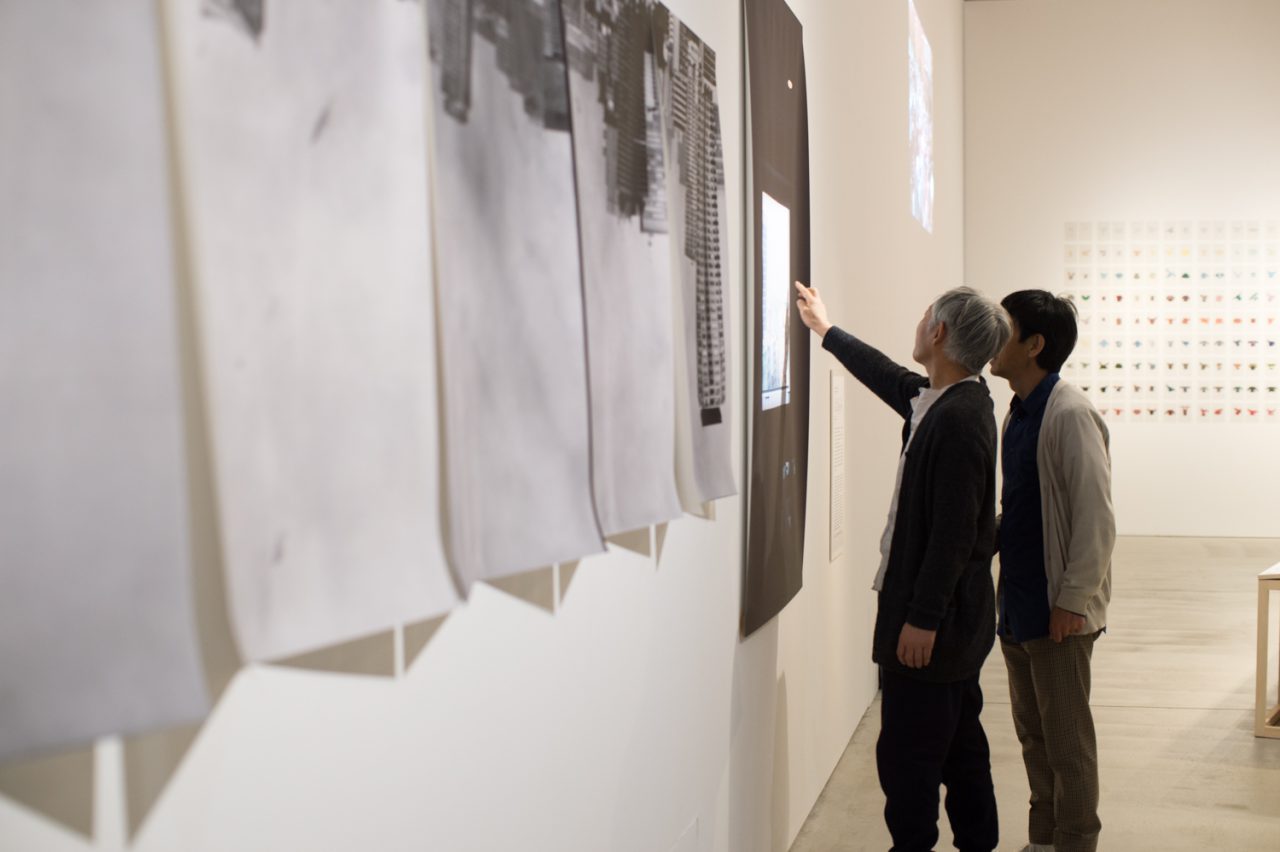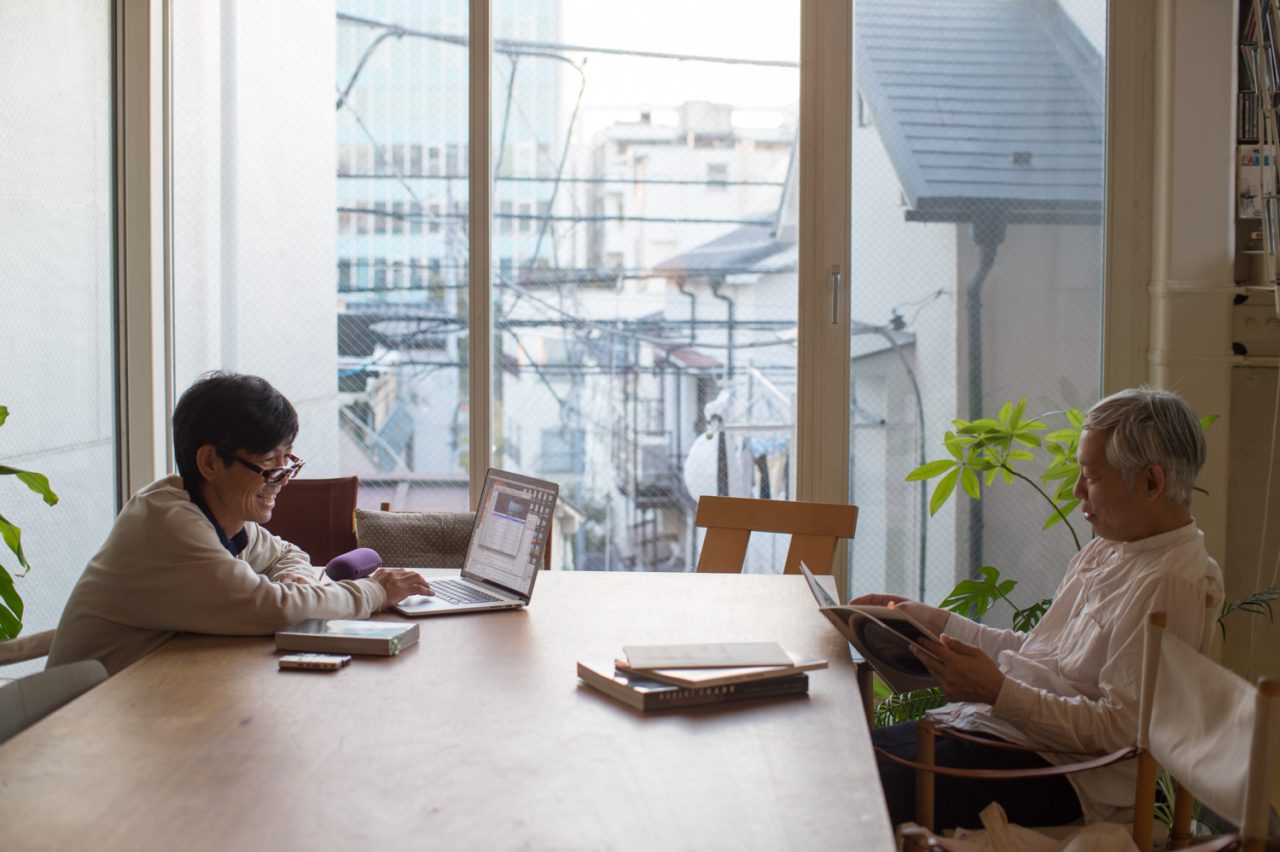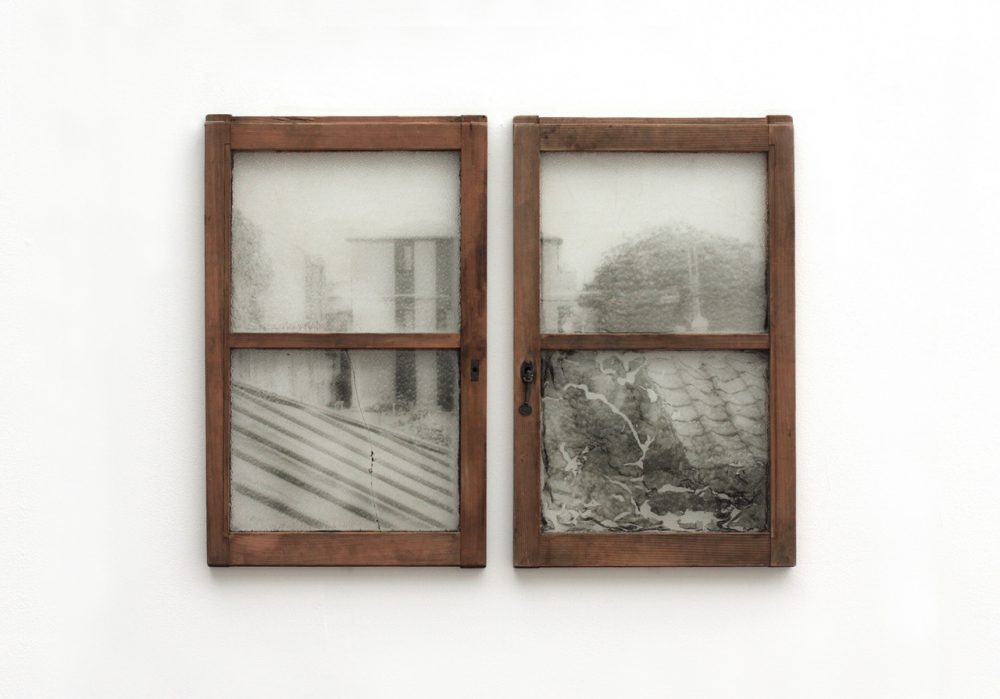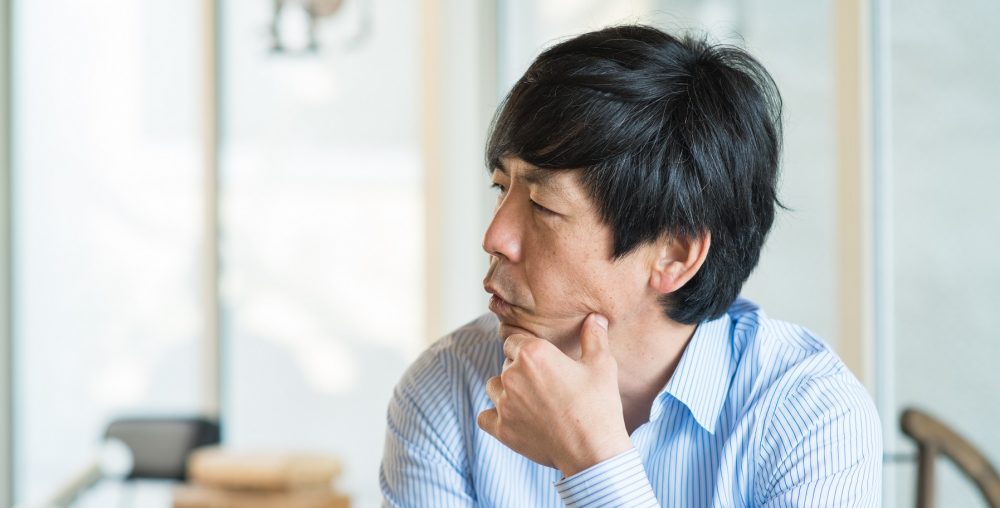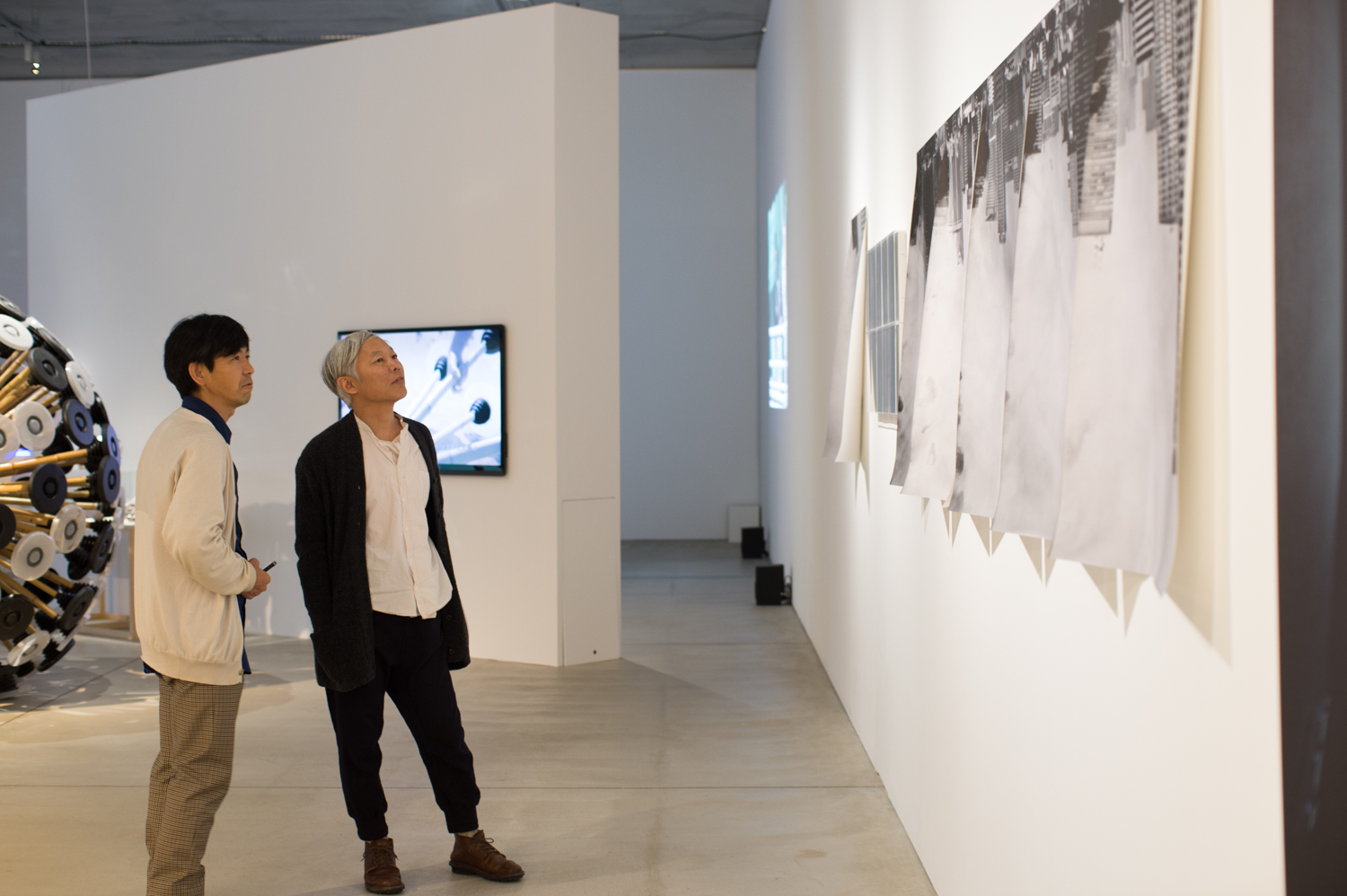
Series Takashi Homma’s Conversations on Photography
Thinking about Windows through Photography
17 Dec 2014
Contemporary photographer Takashi Homma held a conversation on the theme of “Thinking about Windows through Photography” with his long-time acquaintance, architect Yoshiharu Tsukamoto. The session started with Homma explaining his photographic piece Camera Obscura Study — Aoyama→Roppongi, building by building at the exhibition titled THE FAB MIND: Hints of the Future in a Shifting World (October 24, 2014 – February 1, 2015) at the 21_21 DESIGN SIGHT museum in Roppongi, Tokyo.
Takashi Homma (hereinafter referred to as Homma): My piece is from the work that I’m currently doing. Normally, photographers will take photographs on their own by peering into their finder, but what’s nice about this work is that it can be experienced by several people at the same time—for instance, by having everyone darken the room together.
Yoshiharu Tsukamoto (hereinafter referred to as Tsukamoto): I actually once lent a hand with this in New York to photograph the Empire State Building. We sealed off the hotel window and gradually darkened the room.
Homma: It can be experienced by two people like that.
Tsukamoto: Yes, it’s really interesting.
Homma: I thought it would be nice if [the paper] was intentionally allowed to curl up like this in the exhibit.
Tsukamoto: The way the buildings are layered seems different from usual. I have the impression that Tokyo’s buildings are light and thin, yet here they appear to have quite some mass. Maybe it’s also an effect of them being in black and white.
Homma: It’s because this is a bit of a special type of film.
Tsukamoto: This glass building looks massive. It’s not fooling anyone even though it’s covered in glass.
Homma: No, it doesn’t look light.
Tsukamoto: What are these?
Homma: The outside is captured as an inverted image, but the inside of the camera is captured as a correct image. The numbers are prime numbers.
Tsukamoto: I see. So you mean that these are flipped?
Homma: Yes, but from top-to-bottom.
Tsukamoto: So [the numbers] are mounted on glass.
Homma: That’s right. I actually used to make them so that they would float out in front. Do you know [Katsushika] Hokusai’s illustration that shows an inverted image of Mount Fuji projected onto a fusuma screen through the pin-hole effect? I had been thinking about displaying such materials too, but I decided that this should be good enough because everything came together cleanly when I laid these things out in my allocated spot.
Tsukamoto: Hokusai made such an illustration?
Homma: He did.
Tsukamoto: It’s a very subtle phenomenon for one to capture. It really can occur through a small knothole when the rain shutters are closed though.
Homma: There used to be interior spaces that really were pitch-dark back then, so people might actually have seen it happen quite commonly.
Tsukamoto: I remember how the light that came through a knothole in a rain shutter of the house that I lived in as a child once formed an image of the other side on the frosted glass window in front of the shutter. The image was small, though, because the distance was short.
Homma: Such occurrences have rapidly disappeared since the advent of modern architecture because dark spaces aren’t made anymore.
Tsukamoto: That’s true.
-
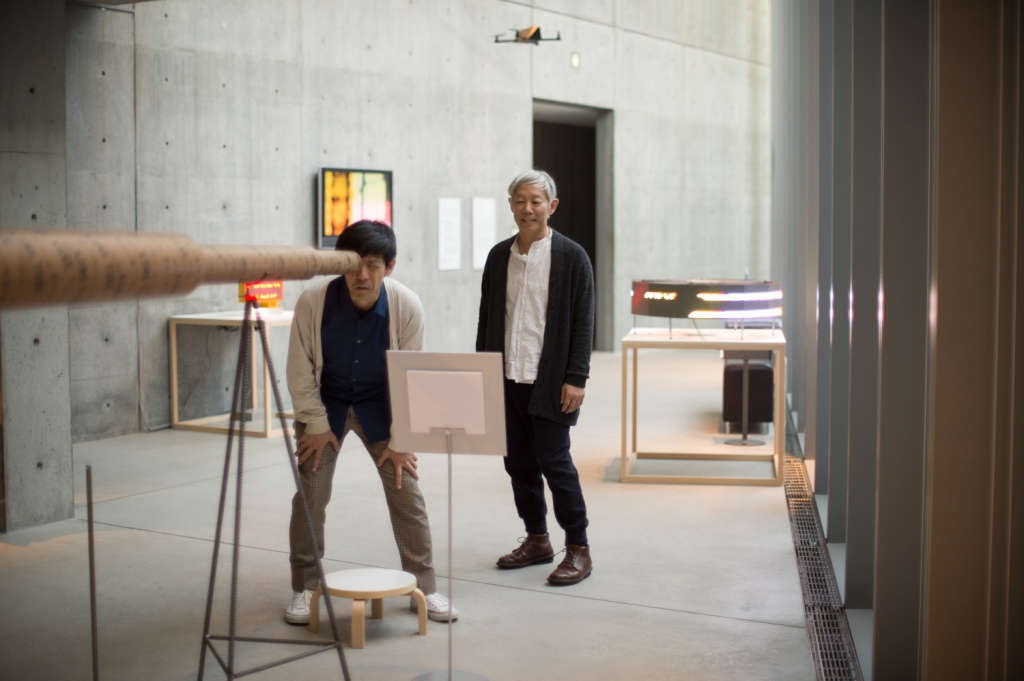
Maki Onishi + Yuki Hyakuda / o+h,
Long Telescope, exhibited in THE FAB MIND: Hints of the Future in a Shifting World
Homma: This is a piece by Onishi’s studio (onishimaki+hyakudayuki architects / o+h). There’s also a long telescope set up some ways over there on the other side, and you can see my work if you look into it.
Tsukamoto: It’s a collaborative piece?
Homma: Yes.
Tsukamoto: Is this like a telescope monster?
Homma: It’s made so that you can view each exhibit.
Tsukamoto: Oh, I see. You’re right!
Homma: I actually don’t precisely understand the concept of this exhibition [laughing]. But each piece is somehow intriguing—such as that minesweeper thing next to mine (Massoud Hassani, Mine Kafon) and that movie over there about the imaginary profession of the near future in which a person walks around while sharing his personal information (Yosuke Ushigome, Professional Sharing)—and the show is very interesting as a whole. As I see it, this exhibition has gathered together people who are working with interesting ideas instead of simply showing already established works of art and design. These are designs and works of art that hint at ways in which we can live in our present age.
Tsukamoto: Yes—designs of hints for living.
The latter half of the session was relocated to Atelier Bow-Wow’s office. Homma shared his ideas on photography while showing photography books that he brought with him, and Tsukamoto shared his ideas about his architectural work.
Homma: Initially, it occurred to me that windows and the views through windows can add some depth to my architectural photographs. When I began working with architectural photography, I felt that there was no point in taking only completion photographs. I had been wondering whether there wasn’t something else that I could do when I came up with the concept of photographing windows and the views through windows.
Tsukamoto: When Homma first told me that, I felt like that was such a contradictory thing for him to say. But at the same time, I agreed with him. He photographed one of our very early projects from Atelier Bow-Wow for us, but, well, Homma basically didn’t take architectural photographs. He was taking shots of such odd places, so I asked him, “Why won’t you shoot this part over here?” But then he said, “Because I’m not an architectural photographer.” He told me, “If you want to shoot it, shoot it yourself—I’ll lend you my camera.” He then went on with taking photographs of the views through the windows and of the windows themselves.
Homma: I understand that the architecture also has various interiors and concepts to it, of course, but I’ll notice how certain places have nice views when I’m actually there.
Tsukamoto: Naturally, we, as the ones designing the architecture, also give thought to how certain places offer good views and to how it would be nice if we can establish a relationship between the act of living and the outside by providing views to the outside from certain spots. Yet, most architectural photographers don’t photograph the views from the windows.
Homma: At first, I had been photographing the views through windows as my personal take on architectural photography. However, in a way, I returned back to the camera from there through my work with the camera obscura that I showed you earlier at the 21_21 DESIGN SIGHT. I might actually have been thinking about the camera when I thought I was taking architectural photographs. I thought it would be really interesting if one considered turning an entire room into a camera. Take this work by Luigi Ghirri, for example. It seems like he made his work while thinking about the photographic frame, which is different again from the architectural window.
Tsukamoto: Ah, this is interesting.
Homma: It’s all about framing.
Tsukamoto: He’s captured the sky.
Homma: To take a photograph means to frame—and windows basically also frame, too.
Tsukamoto: That’s true.
Homma: If you look through these photographs from this viewpoint, you realize that photographers have shot many windows. Robert Frank, for example, has photographed many of them. He frames things in a looser way though. The idea of the camera obscura came to me when I saw this (The Americans [New York: Grove Press, 1959]). It’s based on a completely different direction, but it gave me the initial idea.
Tsukamoto: It looks like the subjects of this photograph are not the actual things but are the reflections. There are several subjects layered on each other. There are also multiple frames, and they are capturing different things.
Homma: I was never taught things like this in school when I was a student. I never learned about it in the photography classes.
Tsukamoto: Actually, nothing is particularly taught about windows in universities either because they’re so obvious for architecture. That’s why they are often only thought of as holes in walls or as things for filling the empty space between a floor and roof. It’s a problem of modern architectural education.
Homma: Right, they’re just seen as things for bringing in light.
Tsukamoto: Japanese architectural education has been molded in relation to industry, so it has positioned architecture in relation to production rather than to the world. However, when a photographer takes photographs by focusing on architectural windows, his relationship is with the world rather than with production.
Homma: I haven’t done it yet, but if I were to properly categorize the photographs, I think they could be separated into several types. For instance, mine are “through-the-window” photographs, and Robert Frank’s are also somewhat so, but [Wolfgang] Tillmans’s are “by-the-window” photographs.
-
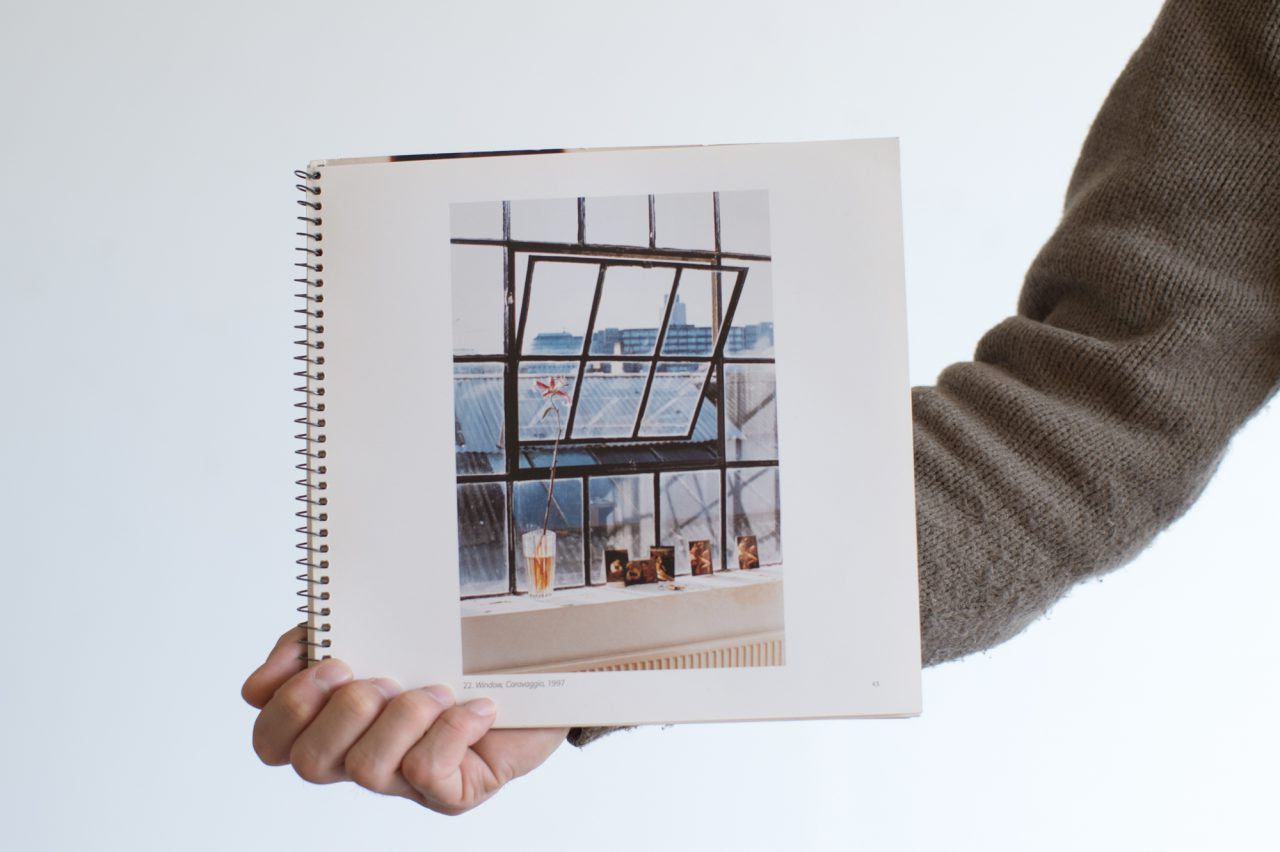
Wolfgang Tillmans window/Caravaggio,1997 C-print Courtesy Galerie Buchholz, Berlin/Cologne
Tsukamoto: They’re windowsides.
Homma: Yes. He seems to take a lot of them.
Tsukamoto: Photographers, film directors, and novelists are sensitive to the phenomena that windows give rise to and to the meanings of windows because they don’t design or produce architecture. I’ve become particular about how I design windows since developing an interest in channeling, or feeding-back, that kind of sensibility into the making of architecture.
Homma: The skylight in the architect-designed apartment that I live in has clearly been designed to be nothing other than a light-catcher, but what I like is the sound that it makes on rainy days. It’s a square opening, and the sound of the rain only comes from there. It’s very beautiful, and it creates a great sensation. That probably is a factor that the architect didn’t envision. I find it interesting how there are things like that that can only be discovered through actually living in a space.
Tsukamoto: Spaces are being made based on such sensations, too. There are several people in the field of contemporary architecture in Japan who are aware of such things, so I think a new way of making architecture that is different from that of twentieth century architecture will soon emerge.
Homma: Actually, traditional Japanese houses were made through the consideration of such things, weren’t they?
Tsukamoto: Yasunari Kawabata is very skilled at writing about such things—such as how sounds from outside enter inside a house and the sound of rain. He describes interiors in a way as if he has taken one step outside. He really possessed an extraordinary sensibility. He fine-tuned the relationship between time and space. I work while holding on to the belief that such sensations can be realized by design, too.
Homma: It’s been kind of interesting how rather than just having architects discuss architecture and photographers discuss photography, we’ve been linking the two by focusing on the single theme of the window.
Tsukamoto: That’s the concept behind the Windowology program. We were just talking about how we should broaden the program in other ways instead of only continuing our ongoing research on architecture.
—We’re interested in researching photography and in classifying photographs of windows. Could we do it together?
Homma: Yes, yes. You can go quite a long way with windows. There are surprisingly few people who have analyzed and discussed photographs with a specific focus on windows even in the photography field. There are people who have been shooting them individually, although I personally used to think that the window is a bit too direct as a theme. Shizuka Yokomizo is one example. she has her subjects stand beside windows in places such as New York. For instance, she would ask you, Tsukamoto, to stand by a window at a particular time, such as at 12 o’clock at night. She would then photograph you from outside without making any communication with you. She takes many photographs like that. People with expressionistic styles of photography used to shoot windows. I disliked windows at the time because I felt that they were too expressionistic, but everyone from Tillmans to Luigi Ghirri was photographing them, so I started to think that they are interesting. This one (Parade—Hoboken, New Jersey, 1955)is a famous photograph by Robert Frank.
Tsukamoto: It shows parts of figures.
Homma: It’s a masterpiece in The Americans.
Tsukamoto: Very tasteful.
Homma: Yes, the way he has framed them is very tasteful.
Tsukamoto: This isn’t a prepared photograph, is it? He didn’t set this up, right?
Homma: No, he didn’t.
Tsukamoto: Amazing.
Homma: There was probably a parade or something happening that day.
Tsukamoto: This photograph captures how even though everyone is watching the parade, there are various ways of participating in it and of distancing oneself in relation to it. Come to think of it, the first photograph in history was also of a view out from a window.
Homma: Yes, the one by [Nicéphore] Niépce.
Tsukamoto: He photographed the view outside through a window in his house.
Homma: Considering that that is where photography began, it should be clear now that the window definitely belongs to the discourse of photography.
Tsukamoto: Modern architecture once attempted to do away with the window. [Ludwig] Mies van der Rohe’s Farnsworth House is just a floor and a roof with glass walls in between them. They are fixed panes. That represented an escape, or severing, from the old era. The window and roof were the most obvious elements to target in attempting this severing. It was thought that one could complete the severing from the past by killing these guys. Ornamentation fundamentally emerges at the edges of things, so the window frame was the center for decorations. If you removed the window, the ornamentation also went away, so this came to be considered as being good practice from a functionalist perspective. However, you actually have a bigger strike zone to work with if you have ornamentation. Even a poorly made building can be saved by it. But if you remove it, the building will turn out terrible if you don’t have good control. The strike zone for architectural design in modernism was very narrow. One reason why the window should be revisited is because it can expand the strike zone.
Homma: Have we discussed enough for today?
Tsukamoto: I think this conversation fits into the context of the past Windowology discussions.
Homma: The idea of a photography segment in the Windowology program fits perfectly with my interests, so I’ll be really happy about it. I have several former workshop-mates who are interested in photography research, so I’ll speak to them about this.
Tsukamoto: This was supposed to be a dialogue, but it’s turned into a project meeting. I think it’s good.
Homma: Yes, it’s always nice when this happens.
Takashi Homma. Photographer. Born 1962 in Tokyo, Japan. Held his first solo museum exhibition, New Documentary, in three museums in Japan from 2011 to 2012. Has published numerous photography books, including Tanoshii shashin: Yoiko no tame no shashinshitsu (Tokyo: Heibonsha, 2009) and Tanoshii shashin 3: Wākushoppu-hen (Tokyo: Heibonsha, 2014). Currently a guest professor at the Tokyo Zokei University Graduate School.
Yoshiharu Tsukamoto. Architect. Born 1965 in Kanagawa, Japan. Graduated from the architecture department of the Tokyo Institute of Technology Faculty of Engineering in 1987. Studied at the Ecole Nationale Supérieure d’Architecture de Paris-Belleville from 1987 to 1988. Began activities as Atelier Bow-Wow together with Momoyo Kaijima in 1992. Completed the doctoral program at the Tokyo Institute of Technology Graduate School of Engineering in 1994. Associate professor at the Tokyo Institute of Technology Graduate School since 2000. Guest professor at the Harvard University Graduate School of Design in 2003 and 2007; University of California, Los Angeles, in 2007 and 2008; Royal Danish Academy of Fine Arts from 2011 to 2012; and Kyoto Seika University in 2013. www.bow-wow.jp
21_21 DESIGN SIGHT | THE FAB MIND: Hints of the Future in a Shifting World
Dates: Friday, October 24, 2014 – Sunday, February 1, 2015
Hours: 11:00–20:00 (last entry 19:00)
Closed: Tuesdays (except December 23) and New Year Holidays (December 27 to January 3)
www.2121designsight.jp
MORE FROM THE SERIES
-

Takashi Homma’s Conversations on Photography
From the “Window” Snapshots of the 1970s to Contemporary German Photography
03 Oct 2018
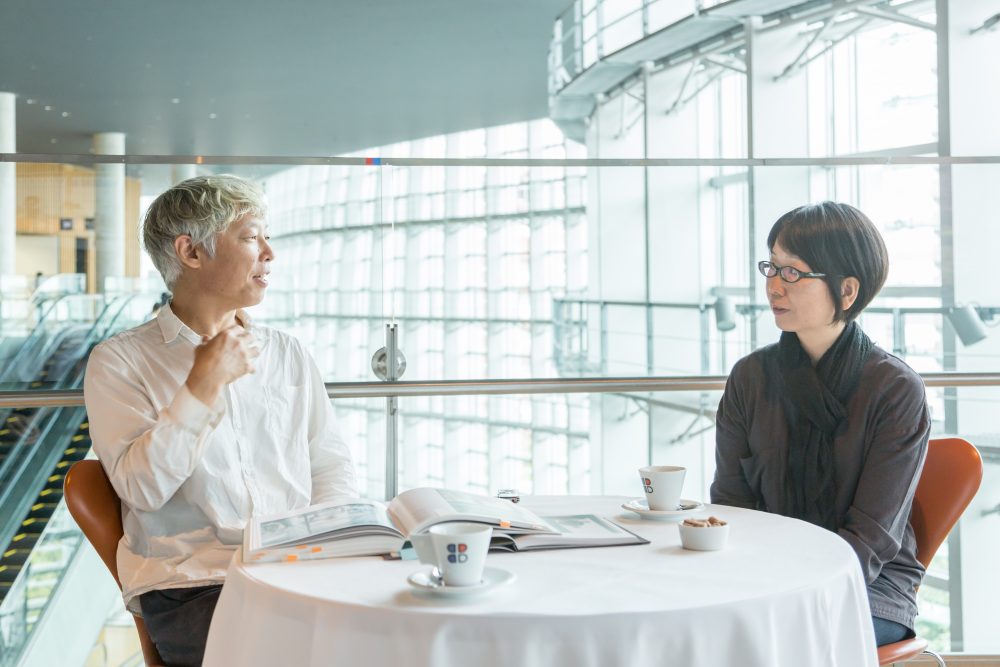
Takashi Homma’s Conversations on Photography
Shizuka Yokomizo + Takashi Homma
The Origin of the Idea26 Sep 2016

Takashi Homma’s Conversations on Photography
MOMAT Collection “Windows and Photography”
06 Sep 2016
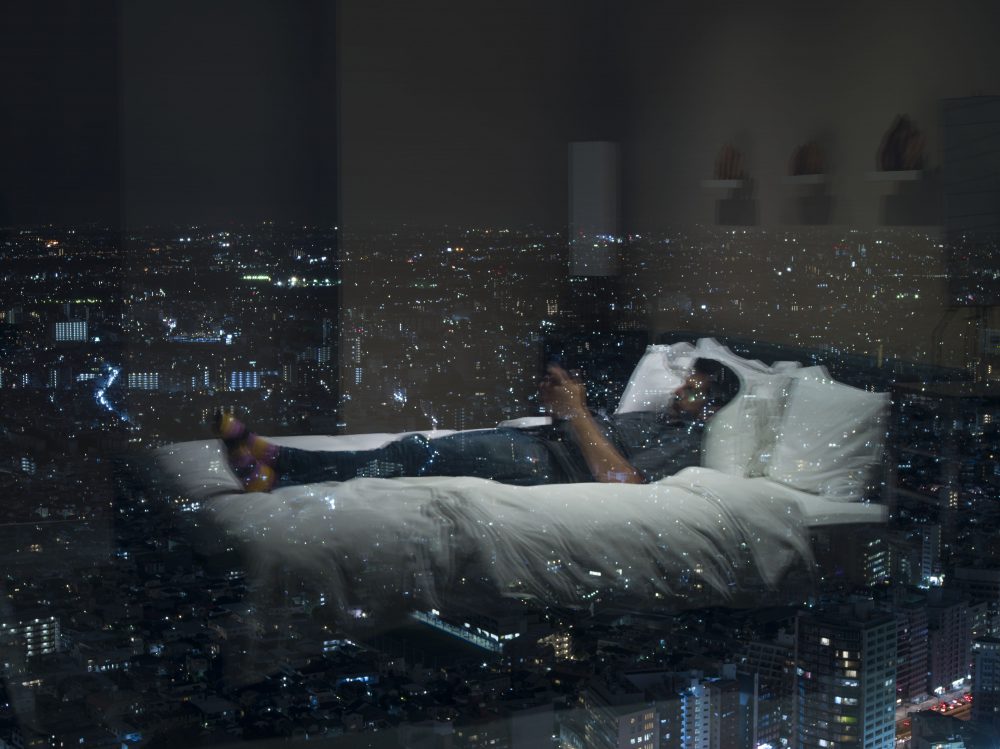
Takashi Homma’s Conversations on Photography
Takashi Homma + Alec Soth
Thinking about Windows through Photography06 Jul 2016

